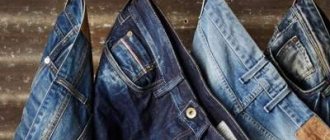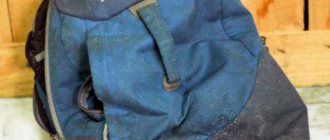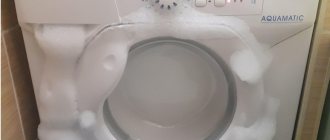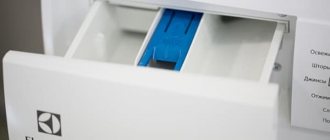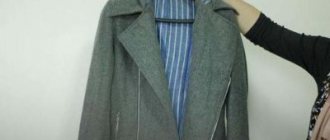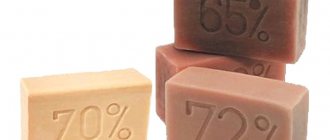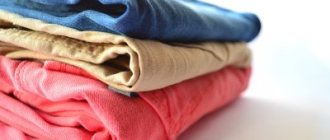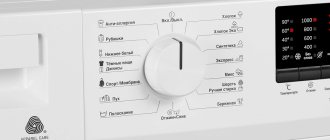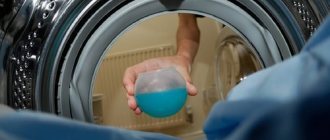Using bleach is the most efficient way to restore the original color of white laundry. Regular powder will not completely get rid of the gray or yellowish tint. And in order to choose the most suitable bleaching agent, it is advisable to understand the bleaching mechanism and navigate the available range.
- When does whitening become necessary?
- Types and purpose of bleaches
- How to use it correctly
- Rating of the best funds
- Expert advice
- Consumer Reviews
When does whitening become necessary?
White linen needs to be washed more often than others, since it is on it that all kinds of dirt are most noticeable. However, after 3-4 washes it loses its original whiteness, turns gray and some stains on it still remain noticeable. The main reasons for the loss of whiteness are the following:
- incorrect choice of program and temperature in an automatic machine;
- storing dirty laundry in a poorly ventilated basket;
- excessively hard water in the water supply system;
- drying in direct sunlight.
Poor quality powder is also one of the reasons for the loss of white color.
cleanhouse.bishkek
tanyasha_der
heitmann_russia
liudmilat6970
Security measures
Manufacturers indicate general safety rules for consumers on bleach labels:
- storage method;
- amount of substance recommended for use;
- precautionary measures.
If a new product is used, an allergy test should be performed first. To do this, you need to place a small piece of fabric in an aqueous solution with the substance. Then apply it to your skin for 3-5 minutes. If itching, redness, or rashes appear, bleach should not be used.
Particular attention should be paid to the use of chlorine-containing products. Be sure to wear protective gloves. If the manufacturer indicates that the concentrate needs to be diluted, the recommended proportions should be followed.
Store bleaches in closed containers, separate from food, in places inaccessible to children and pets. If the expiration date has expired, the product is thrown away. It is more profitable and safer to purchase packages with a small volume.
Do an allergy test
Wear protective gloves
Store products in closed containers, separate from food, in places inaccessible to children and pets.
Types and purpose of bleaches
There are three groups of bleaches available in stores. The division into types is made according to the type of active substance used.
- Chlorine. These products are based on sodium hypochloride. This inorganic substance has pronounced oxidizing properties and is a strong antimicrobial agent. The main scope of application is fabrics made of linen, polyester, cotton and viscose. Regular bleaching with chlorine can deteriorate the strength of the material. Therefore, for more delicate fabrics, it would be wise not to use it at all. The main advantages are low cost and high efficiency.
- Oxygen. Released during the breakdown of peroxyhydrant carbonate or carbonate, oxygen and soda have a more gentle effect on tissues. Therefore, the scope of application of such bleaches is practically unlimited. They do not cause allergies, are suitable for both colored and white linen, and also do not affect the structure of the fibers of the fabric. Oxygen products remain operational in the range of 60-90 degrees and can be washed together with regular washing powder.
- Optical. The principle of their operation is based on the deposition of tiny particles onto the fabric that can reflect ultraviolet radiation (similar to ordinary blue). The technology does not provide for direct destruction of contaminants. Therefore, optical brighteners are used only in conjunction with washing powders. Some samples of powders contain similar agents. The main advantage is the absence of destructive effects on the fabric. The disadvantage is limited use for children's things, since allergic reactions are possible.
Do you store laundry in the washing machine?
Oh yes! No.
What is sodium percarbonate
Sodium percarbonate is a chemical compound with the formula Na2H3CO6, also called solid hydrogen peroxide. It is a colorless solid very similar to bicarbonate. Widely used in powder bleach cleaners. But they usually contain other compounds as surfactants.
The use of sodium percarbonate is interesting because it does not harm the environment. Because upon contact with water it dissociates into hydrogen peroxide and sodium carbonate.
Sodium percarbonate, environmentally friendly bleach for clothes. Which also has many other uses that will surprise you. A universal product that, together with bicarbonate, makes an inseparable pair for the cleanliness of your clothes and cleaning the house.
It was opened just a few years ago. Its creators were looking for more environmentally friendly alternatives to washing clothes.
I'm going to tell you all the secrets of sodium percarbonate. Firstly, what is it and what is it used for. Secondly, how you can add it to your daily cleaning routine without any effort. And not only. Because it is an unusual product that can replace a lot of things in our everyday life.
Oxygen bleaches are an excellent solution for whitening white clothes. And above all, color stain removers in one product, since they do not contain chlorine, are an ideal safe and convenient alternative.
If you don't already use one or don't know which one to choose, in this guide I will select the best oxygen bleaches for clothes. These will be the bleaches available in the market that are not easy to choose from so that you can care for your clothes as if they were new.
Oxygen bleaches are possibly a disintegrator, stain remover and highlighter for original fabric colors.
How to use it correctly
To avoid mistakes, it is advisable to first read the instructions for the washing machine. There will be an interesting section in it that describes the purpose of the compartments of the detergent tray. Most often, bleaching agents are added to the powder compartment for the main wash.
Expert opinion
Irina. Housewife.
Ask a Question
The amount of the substance is determined taking into account the recommendations on the box or bottle of bleach. The markings applied to the walls of the tray will help you avoid transferring too much.
If desired, bleaching agents can be poured or poured directly into the drum. However, in this case it is necessary to dilute the product with a small amount of water. This will protect the chrome coating, as well as rubber hoses and gaskets inside the SMA, from corroding.
It is possible to use chlorine bleach in your machine, but it may cause it to wear out faster. It would be wiser to first process the items manually, and then send them to the machine for rinsing and the main wash.
Do you wash by hand?
Oh yes! No
Options for using whiteness
Bleach is used for various purposes:
- for whitening things, removing yellowness and grayness;
- to remove stains (including stubborn stains);
- for disinfection of plumbing fixtures, floors and other surfaces;
- to remove mold and mildew;
- for cleaning sewer pipes and drains;
- for water disinfection;
- to remove carbon deposits;
- for dyeing things in the “tie-dye” style;
- to add shine to glass products;
- for washing windows;
- for weed control.
Expert advice
The easiest way to achieve high-quality whitening is if you take into account the nuances of using a particular bleach.
Dr. Beckmann
Requires careful selection of the product used. It comes in three versions: “For curtains and curtains”, “For underwear and lace”, and the universal “For perfect whiteness”.
Each of them is effective only for the specified types of fabrics. When washing, it is best to use rubber gloves to protect against aggressive composition.
Dr. Beckmann
Liby
Even if you choose the flavored option, there is a distinct chlorine smell. It is optimal to use the product for bleaching thick fabrics, as well as for washing floors and dishes.
Bleach Liby
Ace
While effective on heavy soiling, this product has an aggressive effect on fabric. Therefore, it is undesirable to use it for a long time for the same things. It also has a specific odor, to remove which it is recommended to use a program with an additional rinse.
Bleach Ace
"White"
When working with this product, it is better to use hand protection. An unpleasant effect is an increase in the hardness of the material after washing.
White
The choice of one or another bleach for use in an automatic washing machine depends on the specific situation. Somewhere it makes sense to put up with the smell of bleach, but it is guaranteed to bleach thick fabric . On the contrary, it is worth paying attention to the need for delicate handling. In each case, before adding bleach, you need to study its capabilities and features.
Video
Rules for using the product
Before using Belizna, it is recommended to study the instructions for use of the product in order to accurately observe the proportions when preparing an aqueous solution. Following the rules will help you bleach things at home without damaging them. The processing methods described below are suitable for cotton and linen fabrics, fine synthetics.
We maintain the whiteness of the fabric. To keep a white shirt, bed linen or tablecloth in perfect condition, briefly soak the items in a bleach solution. To do this, you will need a container, 10 liters of cool water and no more than two tablespoons of bleach.
After thoroughly stirring the solution, the prepared items are immersed in it and left for 15-20 minutes, no more. Then the items need to be rinsed in plenty of cold water and washed with powder, manually or in a machine.
Restoring fabric whiteness. Grayness, yellowness and stains from faded items are removed in the same way as above, but you will have to soak a shirt, bed linen or tablecloth in the working solution for an hour.
Removing stains from thick fabric. Let's look at how to bleach white items made from thick calico, jeans, thick linen and other materials with a similar structure. In this case, you can apply “Whiteness” to the stains undiluted and let it sit for one minute. Then the item is soaked in a solution of standard proportions, kept for another 20-30 minutes and washed.
A bleach-based gel will also help whiten tulle that has turned yellow or gray with time and exposure to sunlight. Nylon tulle, voile curtain or organza should be placed in a gentle solution of “Belizna” for 5-10 minutes - 1 tablespoon of the product per 10 liters of cool water.
Note! You should not use bleach frequently, since the solution, even in a gentle concentration, causes damage to fabric fibers - they split and become thinner. Bleach is an effective remedy, but it can quickly ruin the product.
